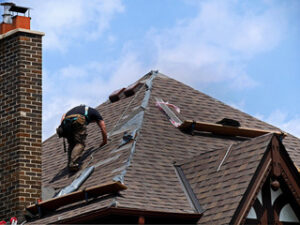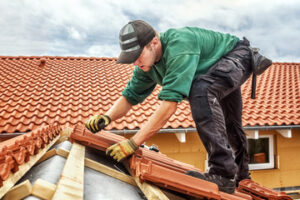Severe storms and high winds are your roof’s worst enemy. High winds can damage shingles and other roofing materials, dislodging them and causing them to lift. Look for signs of wind damage such as cracked housings on plastic roof vents or broken seams on metal ones. Also watch out for water stains on ceilings and walls, as these indicate your roof is damaged.
Damaged Shingles
If you notice your neighbors are on the roof repairing or replacing shingles, it’s a good idea to check out your roof for damage. The difference between regular wear and tear and serious damage will likely be apparent in dark spots or uneven shingle coverage on your roof. A home inspector from Roofing Company Colorado Springs can tell you if these signs indicate a necessary repair or replacement.

In addition to general wear and tear, a major problem with your roof may be caused by wind or hail damage to the shingle’s surface or flashing. In this case, it’s best to contact a roofing specialist who can determine whether you have a valid insurance claim and the extent of the damage.
Some types of shingle damage include creased or flipped shingles, where the shingle tab is lifted up and over an adjoining shingle, or it is folded down and a crease or flap is created; blistering, where small pockets of air are formed in the shingle’s asphalt coating and can be felt as bumps under the shingle when you walk on the roof; and cracking of the shingle surface due to age, sun exposure and other environmental factors.
Another common type of shingle damage is loss of the granules, which protect the asphalt shingle’s surface and add fire resistance. While it is normal to lose a few granules over time, if the number of granules in your gutters or yard increases, you probably have roof damage and should have the area checked by a professional.
Replacing a single damaged shingle is not difficult, but it’s definitely a job for a professional. You’ll need a hammer, a flat pry bar and a handful of 11/4-in. roofing nails. To remove a nail, start at the bottom edge of the shingle and slide the pry bar under the shingle directly above it, then pry upward until the nail pops up about 1/4 in. Pull out the nail and then gently lift the shingle to free it from its sealer strip. After the damaged shingle is removed, nail a new one into place starting at the bottom edge of the roof and moving up in a pyramid pattern.
Fascia Damage
The fascia board is a critical part of the roof eave and gutter system. It helps to keep water from damaging the roof shingles and allows air to circulate. In addition, the fascia holds up the soffit which is installed under overhanging roofs. It’s important to check the condition of the fascia and soffit on a regular basis. If the boards become rotten everything that is attached to them will be at risk of falling off your home.
The best way to identify a rotten fascia is by looking for discoloration in the wood. When this happens the paint that was protecting the fascia has worn away, leaving the wood exposed. It’s also a good idea to inspect the eaves of your home for areas where the wood seems soft and crumbly. It may even appear that the gutters are sagging. This is a sure sign that the fascia has rotted.
If you notice a section of the fascia has rotted it’s best to replace it. It’s important to do this before the rot gets worse. If you choose to replace the fascia yourself, it’s a good idea to remove the old board and examine the framing materials that are underneath it. If the underlying material is badly rotted, it will need to be replaced too.
Moisture damage is a common cause of rotting fascia. A roof leak, a gutter clog or other roofing problems may leave the fascia exposed to moisture on a consistent basis. This will eventually lead to wood rot that could affect the stability of the gutters and the roof overhang.
Mold, fungus and black stains on the fascia are also signs of moisture damage. These growths can spread quickly from one area to another, causing the whole fascia to be ruined.
The best way to prevent this type of damage is to ensure that the fascia and soffit are properly caulked and painted. This will help to protect them from moisture damage and make it easier to spot if there are any problem areas. It’s also important to keep animals and insects away from the soffit and fascia as much as possible.
Water Leaks
A roof should protect the inside of a home from rain and other precipitation. If it isn’t doing that, water can seep through and damage other structures in the home such as drywall and insulation. This can also create rot and mold.
If you suspect that your roof is leaking, look in places you can’t normally reach to find the source of the problem. For example, if you spot water spots on the ceiling, check to see if they’re directly above a shingle or flashing leak. Leaks are often caused by pinholes or other small failures in caulking and other exterior materials, so locating the leak may take a bit of detective work.
Another sign of a water leak is if you notice stains on the ceiling or walls. Water leaks can leave dark stains that are usually brown or yellow in color. The darker the stain, the more severe the leak.
Look for water stains on the ceiling, drywall and flooring around the area of a leak. This may indicate that the leak has been there for a long time and that it has rotted or caused other structural problems in your home. You can also check for rust on metal flashing, as well as dents and warped material.
If you do spot a leaking area, it’s important to call in a professional as soon as possible. This will help ensure that the damage is properly repaired before it can become worse, and it may even be covered by insurance. Depending on your homeowners policy, the insurance company may send an adjustor to inspect the damage and give you an estimate.
It’s also a good idea to keep track of the repair process and who you’ve spoken to at the insurance company. This can help avoid misunderstandings and frustration, and it will give you a better understanding of the status of your claim. In many cases, if the damage is severe enough, a tarp may be put up while your roof is being fixed to prevent further damage. Keeping records can also help you avoid being overcharged by contractors or the insurance company.
Mold
If water from a roof leak accumulates in the attic, it can lead to mold growth and mildew. This is not a problem you want in your home, as these fungi wear away at the wood and drywall, and can also cause health issues for family members. The spores produced by these fungi can trigger allergy symptoms, breathing problems and other serious health conditions.
Mold and mildew need moisture to thrive, and the humidity provided by some roof leaks can make conditions ideal for these fungi. Once they have taken hold, these spores can spread through the ventilation system in your home and contaminate the air you breathe. This can cause allergies, respiratory issues and other health problems for everyone in your home.
One of the quickest ways to identify mold is by its rancid smell. If you notice this odor, it is a clear sign that the mold is from a roof leak and should be removed as soon as possible. Another way to spot a mold problem is by looking for discoloration or dark spots on the ceiling. These spots indicate that the affected area is saturated with water from a roof leak.
Once the conditions are right, mold spores can begin to grow within a few days. Once the spores are established, they will continue to grow until the area is cleaned and the underlying problem is fixed. Mold growth caused by a roof leak is often confined to the attic, drywall and insulation in the affected area, but if it goes untreated, the mold can spread throughout your home.
If the mold is limited to a small area, it may be easy for you to remove on your own. This involves finding and fixing the source of the leak, spraying the affected area with a fungicide and scraping it off. Once the area is completely dry, it will need to be monitored over the next few weeks to ensure that the mold does not return.
However, if the mold growth is extensive and requires professional removal, it is best to consult a specialist. A professional will be able to find and fix the source of the leak, as well as spray a fungicide to kill any existing spores and clean the affected areas.

 If your roof is sagging, replacing it can be expensive. This will involve removing the old roofing and installing underlayment to protect the rest of the roof. The National Roofing Contractors Association recommends that all roofs have an underlayment. In addition, the installation of drip edge flashing will protect the shingles from water leakage.
If your roof is sagging, replacing it can be expensive. This will involve removing the old roofing and installing underlayment to protect the rest of the roof. The National Roofing Contractors Association recommends that all roofs have an underlayment. In addition, the installation of drip edge flashing will protect the shingles from water leakage.